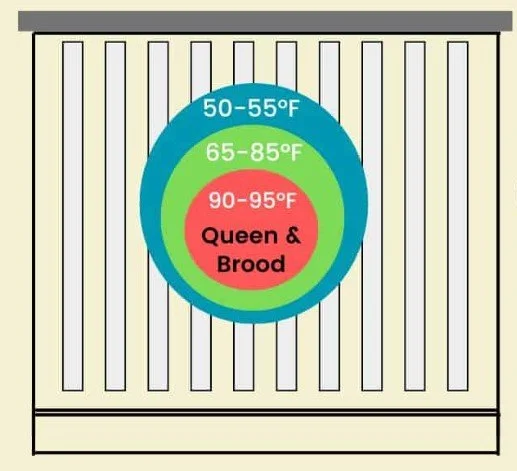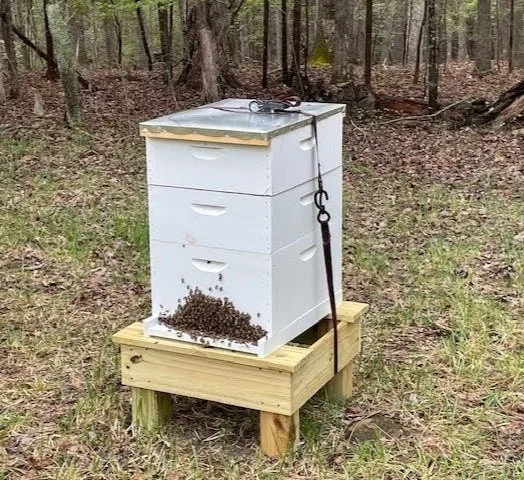Temperature Duality: The Heterothermic Mastery of Honey Bees
Despite being “cold-blooded insects,” honey bees are masters of temperature control—not just for themselves, but for their hive, queen, and, most importantly, their brood. What makes them truly remarkable is their ability to function as both ectotherms (which is what insects are generally considered to be) AND endotherms, earning them the title of “heterotherms.” In warm weather, they behave like ectotherms, relying more on external temperatures to regulate their internal temperature. But in winter, they switch gears, becoming endotherms that generate their own heat to survive. As you'll see throughout this blog, honey bees use incredibly complex strategies to regulate temperature across the seasons, for both hot and cold seasons. Their adaptations are as unique and specialized as the bees themselves!
Individual Body Temperature Regulation
Inside the hive, honey bees regulate body temperature collectively. However, when a forager ventures out alone on a colder day, she must warm her thorax—the section housing her powerful flight muscles—to at least 30°C (85°F) before taking flight. This process is accelerated in direct sunlight, which is why hives with sun-facing (ideally southeast) entrances see earlier morning foraging.
Honey bees generate heat by vibrating their flight muscles without moving their wings, similar to shivering. However, maintaining this heat is challenging because the abdomen, which contains the honey stomach, is much larger than the thorax and logically would draw heat away from the flight muscles. To prevent this, honey bees have a “counter-current heat exchanger” in the narrow petiole (waist) between the thorax and abdomen. This system minimizes heat loss by looping warm hemolymph (bee blood) from the thorax back through the petiole before it reaches the abdomen, ensuring flight muscles stay warm without under or overheating the digestive organs.
In addition to tolerating low temperatures, honey bees can also fly in extreme heat—up to 46°C (115°F). In extreme heat, their thoracic temperature remains slightly lower due to their special “evaporative cooling” mechanism. When exposed to high temperatures, a worker bee regurgitates a droplet of nectar onto her proboscis (tongue). As the water in the nectar evaporates, it cools the bee’s head, which in turn draws heat away from the thorax. This adaptation allows honey bees to forage in temperatures that would be lethal to many other insects.
A Cool Aside: The thermal image below is fascinating—it vividly highlights the real time difference between an endothermic and ectothermic honey bee. The endothermic bee has a warm thorax and head, and a much cooler abdomen. These bees are likely heater bees or foragers, either generating heat for the colony or warming up before heading out to forage. In contrast, two other bees appear in lighter shades of blue, indicating they are currently in an ectothermic state. These bees are likely staying inside the hive, relying on social thermoregulation rather than producing their own heat.
Social and Stenothermic Thermoregulation
Honey bee brood—which includes eggs, larvae, and pupae—is stenothermic, meaning it requires precise temperature regulation between 33°C and 36°C (91–96°F) for proper development. While brood generates some metabolic heat, it’s not enough on its own, so worker bees are in charge of picking up the slack. One way they coordinate this effort is through pheromones, which are chemical signals that help regulate colony behavior. Even developing brood produces pheromones, including one that signals when they’re too cold, prompting workers to provide warmth.
Honey bees maintain colony temperature through social thermoregulation, where individual efforts collectively regulate hive conditions, particularly during seasonal weather changes. In winter, when no brood is present, the hive temperature drops slightly but remains relatively stable. When the queen is actively laying throughout the rest of the year, maintaining precise temperatures is critical. Eggs and larvae in uncapped cells can tolerate brief cooling, but pupae in capped cells are highly sensitive. Unlike uncapped cells, which absorb heat from the colony, capped cells trap pupae inside, cutting them off from warm ambient air. As beekeepers, we’re always careful to avoid exposing all stages of brood to dangerously cold conditions during inspections!
If you look at a capped brood frame (see photo below), you may notice some holes in the wax capping—these could be spots where worker bees already hatched or a developing larvae was cleaned out prematurely, but some may also be empty cells left by the queen on purpose. Regardless of their occurrence, heater bees know they can insert their abdomens into these empty cells and use their thoracic flight muscles to generate heat, which spreads through the wax walls to warm nearby developing capped pupae. Beyond brood care, heater bees also help regulate overall hive temperature, making them crucial to the colony’s survival.
Another Cool Aside: Brood raised closer to 33°C (91°F) tend to be poor foragers but excel as heater bees, making them especially important during winter. These bees take on the crucial role of maintaining hive warmth through the coldest months, ensuring that new spring bees develop properly at temperatures closer to 36°C (96°F). These warmer-reared bees will hatch in spring and will be stronger foragers than the winter heater bees. This temperature-dependent development helps the colony adapt to seasonal needs—winter bees prioritize survival and thermoregulation, while spring bees emerge optimized for foraging to support colony growth and food stores.
Keeping the Queen in Check
When a virgin queen emerges from her cell and undergoes the process of being "chosen" to take the throne, she must then embark on her mating flight(s)—note the possible plural! This is a somewhat controversial topic, as many believe queens only go on one mating flight during their lifetime, which is likely the case most of the time. However, a newly emerged queen may take her first flight and follow it with a second one shortly after. When a virgin goes on a mating flight, she mates with around 15 drones and stores up to 7 million sperm in a special organ called the spermatheca (see photo below). She must hold onto this stored sperm for her entire life, making the success of her mating flight(s) very important for the survival of the colony!
Like in mammals, drone sperm is temperature-sensitive, so the queen must avoid extreme temperatures to keep her spermatheca's contents viable. While the queen isn’t particularly sensitive to temperature fluctuations herself, she relies on the hive’s social thermoregulation to maintain optimal conditions for her stored sperm. Interestingly, her ovaries continuously produce eggs throughout her life, unlike human ovaries, and remain unaffected by extreme temperatures. Since the queen’s ovaries produce eggs on an as-needed basis, they aren’t being generated during seasons when extreme heat or cold could affect their viability.
While the queen's thermoregulation is crucial for keeping her sperm stores viable, maintaining the right brood nest temperature is just as important for another reason—triggering the queen to start laying eggs. If the brood nest temperature drops below 23°C (74°F) or rises above 34°C (94°F), she likely won’t lay any eggs (see table below). This egg-laying temperature range is surprisingly broad and shifts with the seasons. For example, in spring, when the colony is rapidly expanding in preparation for swarming, the queen lays the most eggs per day (up to 2,000). During this time, she may use the entire temperature range rather than limiting egg-laying to the optimal 31–33°C (88–91°F). This seasonal flexibility helps a colony grow as quickly as possible in spring, ensuring it reaches peak size before reproducing via swarming.
The Winter Cluster
Honey bees pull off an incredible feat of survival to make it through winter. Since bee brood can’t survive if the colony’s temperature drops below 33°C (91°F), the queen takes a brood break, pausing egg-laying until early spring. The worker bees raised in fall are built differently—they can live four to six months (changes regionally), while those born in warmer seasons live only about six weeks.
All winter long, the colony has one job: to stay warm. Worker bees huddle together in a tight cluster around the queen, shivering their flight muscles to generate heat. At the core of the cluster, the queen stays cozy at around 34°C (93°F). While rare, if any brood remains in late fall, the bees will cluster around it to help it hatch before temperatures drop too low. The cluster has multiple mantle layers surrounding the core, with warmth gradually fading toward the outer edges.
As the temperature outside falls, the bees adjust their formation—contracting to conserve heat and expanding when warmth allows, almost like a balloon inflating and deflating. And just like penguins in the Antarctic, they rotate positions, taking turns between the toasty center and the chilly outer layers to keep as many workers alive as possible.
For more information on honey bees during winter, check out our previous blog: What Happens to Honey Bees in the Winter?
Mini Evaporative Cooler Unit
During the hot summer months, you may notice worker bees gathering at the hive entrance—a crucial behavior for temperature regulation and honey production. As shown in the video below, this process helps keep the hive cool and aids in curing honey.
Some foraging workers collect and carry water back to the hive in their honey stomachs, then regurgitate it near the entrance. Other workers, known as fanning bees, use their wings to pull fresh air and the delivered water into the hive, creating an effect similar to evaporative cooling. This method is highly effective in dry climates, where water evaporation efficiently lowers temperatures.
Beyond cooling, this airflow serves another key purpose: accelerating the honey-curing process. When foragers bring nectar back to the hive, it contains up to 80% water. Before sealing it with wax cappings, workers must reduce the water content to 18% or less to transform nectar into stable, ever-lasting honey. The steady movement of air through the hive speeds up the evaporation process, helping the colony produce honey more efficiently.
Another key summer cooling strategy is bearding—when a portion of worker bees gather outside the hive entrance in a dense cluster. By relocating themselves outside, they reduce the heat buildup inside, helping to keep the brood and queen from overheating. Some of these bearding bees also fan their wings, drawing cooler air into the hive to further aid in temperature regulation.
Sources:
https://www.bennington.edu/sites/default/files/sources/docs/Sherman_thermoregulation%20in%20bees.pdf
https://pmc.ncbi.nlm.nih.gov/articles/PMC2813292/
https://www.beeculture.com/a-closer-look-25/
https://kb.osu.edu/server/api/core/bitstreams/b2da3eec-fc20-5296-86b2-5e1c8629e6ee/content
https://www.researchsquare.com/article/rs-280020/v1
https://www.youtube.com/watch?v=EtMkF6MYYT0








